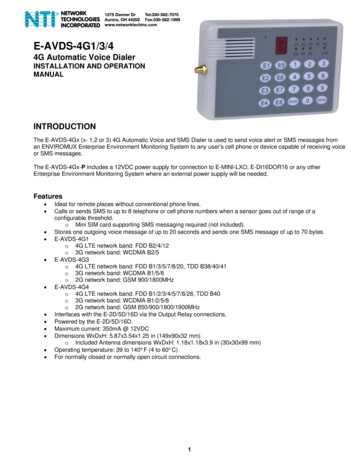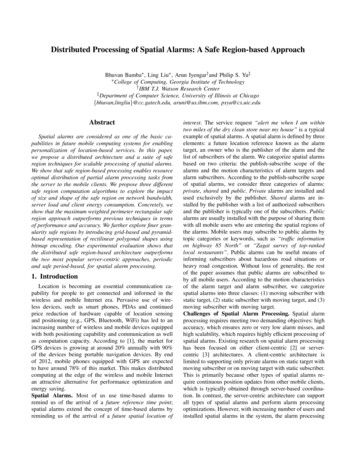
Transcription
UNIVERSITY OF NAIROBICOLLEGE OF ARCHITECTURE AND ENGINEERINGSCHOOL OF ENGINEERINGDEPARTMENT OF ELECTRICAL AND INFORMATIONENGINEERINGPROJECT: SMOKE ALARMPROJECT NUMBER: 107NAME: NG’ANG’A RENSON NGOCHIREG. NO: F17/1421/2011SUPERVISOR: DR. C.W. WEKESAEXAMINER: PROF. M. K. MANG’OLI
A project report submitted to the Department of Electrical andInformation Engineering in partial fulfilment of the requirements for theaward of BSc. Electrical and Electronic Engineering of the University ofNairobi.i
DECLARATION OF ORIGINALITYNAME:NG‟ANG‟A RENSON NGOCHIREGISTRATION NUMBER: F17/1421/2011COLLEGE:Architecture and EngineeringSCHOOL:EngineeringDEPARTMENT:Electrical and Information EngineeringCOURSE NAME:PROJECT:BSc. Electrical and Electronic EngineeringSMOKE ALARM1) I understand what plagiarism is and I am aware of the University policy on thisregard.2) I declare that this final year project is my original work and has not beensubmitted elsewhere for examination, award of degree or publication. Where otherpeople‟s work or my own work has been used, this has properly beenacknowledged and referenced in accordance with University of Nairobi‟srequirements.3) I have not sought or used the services of any professional agencies to producethis work.4) I have not allowed and shall not allow anyone to copy my work with theintention of passing it off as his/her own work.5) I understand that any false claim in respect of this work shall result indisciplinary action, in accordance with University anti-plagiarism policy.ii
Signature: . .Date: . .iii
DECLARATION AND CERTIFICATIONThis is my original work and has not been presented for any degree award in this or any otheruniversity. Information from other sources has been duly acknowledged. NG‟ANG‟A RENSON NGOCHIF17/1421/2011This report has been submitted to the Department of Electrical and Information Engineering,University of Nairobi with my approval as supervisor: .DR. C. W. WekesaDate: .iv
DEDICATIONThis project is dedicated to my parents, James Ng‟ang‟a Mwangi and MarthaWamaitha Ng‟ang‟a and my siblings, Catherine Nyambura, Martin Mwangi andCaroline Wairimu for their unwavering financial and emotional support as well asundying love and encouragement throughout my academic journey.v
ACKNOWLEDGEMENTFirst, I would like to thank the Almighty God for granting me life and good healthas well as supreme protection and guidance throughout my studies.I am thankful to my supervisor, Dr. C. W. Wekesa for his informative and usefulguidance and suggestions throughout the journey for project design.I am very grateful to the Department of Electrical and Information Engineering andmy lecturers for instilling in me the knowledge that has brought me this far.I am thankful to my friends and classmates who have contributed to the success ofmy studies through their wise counsel and support.Needless to mention, this project would not have been complete without referenceto and inspiration from the work of others whose details are included in thereference section of this document.vi
Table of ContentsDECLARATION OF ORIGINALITY . iiDECLARATION AND CERTIFICATION . iv DEDICATION . vACKNOWLEDGEMENT . viTable of Figures . ixCHAPTER 1: INTRODUCTION . 11.1 BACKGROUND . 11.2 PROBLEM STATEMENT . 21.3 OBJECTIVES . 21.4 SCOPE OF WORK . 2CHAPTER 2: LITERATURE REVIEW . 32.1 LDR-BASED SMOKE DETECTOR . 42.2 PHOTO INTERRUPTER MODULE-BASED SMOKE SENSOR . 52.3 RE46C190 PHOTOELECTRIC SMOKE DETECTOR . 92.4 SMOKE DETECTOR WITH GAS SENSOR TGS 813 . 102.5 MQ2 SENSOR-BASED SMOKE DETECTOR . 13CHAPTER 3: REVIEW OF COMPONENTS USED . 163.1 MQ2 SMOKE SENSOR . 163.2 ATMEGA 32A . 203.3 LCD MODULE . 243.4 BUZZER . 303.5 LED . 303.6 POWER SUPPLY MODULE . 31CHAPTER 4: DESIGN . 344.1 HARDWARE DESIGN . 354.1.1 MQ2 SENSOR . 354.1.2 ATMEGA 32A. 364.1.3 INTERFACING LCD TO ATMEGA 32A . 364.1.4 VISUAL ALARM (LEDs) . 394.1.5 AUDIO ALARM (BUZZER) . 404.2 SOFTWARE DESIGN . 424.2.1 ADC PROGRAM . 43vii
4.2.2 LCD PROGRAM . 454.2.3 ALARM ACTIVATION PROGRAM . 454.3 PCB DESIGN . 46CHAPTER 5: RESULTS . 475.1 SIMULATED RESULTS . 475.3 RESULTS AFTER IMPLEMENTATION . 50CHAPTER 6: CONCLUSION AND RECOMMENDATION . 556.1 CONCLUSION . 556.2 RECOMMENDATIONS. 56References . 57APPENDIX 1: CIRCUIT DIAGRAM . 58APPENDIX 2: ATMEGA 32A BLOCK DIAGRAM . 60APPENDIX 3: C PROGRAM. 61APPENDIX 4: COST . 64viii
Table of FiguresFigure 1Symbol of LDR . 4Figure 2 Schematic and block diagram of LDR based smoke detector . 5Figure 3 Symbol ofPhotointerrupter . 6Figure 4 Pin diagram of Photo Interrupter Module . 6Figure 5 Photo interrupter module . 6Figure 6 Typical photo interrupter circuit for digital logic . 7Figure 7 Block Diagram for LM 555 . 8Figure 8 Connection diagram for 555 timer as an Astable Multivibrator. 9Figure 9RE46C190 application circuit [5] . 10Figure 10 TGS 813 configuration [6] . 11Figure 11 TGS 813 Diagram for Electric Circuit [6] . 11Figure 12 Basic Measuring Circuit with TGS sensor [6] . 12Figure 13 MQ2 sensor . 14Figure 14 Connection diagram for MQ2 sensor . 15Figure 15 Structure of MQ2 [7] . 18Figure 16 ATmega 32A . 20Figure 17 Pinout PDIP ATmega 32A [8] . 23Figure 18 LCD image . 25Figure 19 Buzzer . 30Figure 20 Electronic Symbol for LED. 30Figure 21 Parts of an LED . 31Figure 22: FLOWCHART FOR PROJECT DESIGN PROCESS . 34Figure 23: MQ2 SENSOR . 35Figure 24 Basic measuring circuit for MQ2 . 36Figure 25:Microcontroller-LCD interface simulation . 39Figure 26 Microcontroller - LEDs interface simulation . 40Figure 27 Final design of smoke sensor (Excluding the power supply) . 41Figure 28 FLOWCHART FOR SOFTWARE DESIGN . 42Figure 29 :LCD DISPLAY IN SMOKE DETECTED MODE SIMULATION . 48Figure 30: LCD DISPLAY IN STANDBY MODE SIMULATION . 49Figure 31Final Circuit with power switched off . 50Figure 32 Circuit on breadboard with INSIGNIFICANT quantity of smoke detected . 51Figure 33Final Circuit with INSIGNIFICANT quantity of smoke detected . 52Figure 34 Circuit on Breadboard with SIGNIFICANT quantity of smoke detected . 53Figure 35 Final Circuit with SIGNIFICANT quantity of Smoke Detected . 54ix
CHAPTER 1: INTRODUCTION1.1 BACKGROUNDA smoke alarm is a device that senses smoke, typically as an indicator of fire. Itmay issue a signal to a fire alarm control panel as part of fire alarm system,especially in commercial security devices or may issue a local audible or visualalarm in the household [1].Fire detection has become a crucial aspect in design of buildings, both commercialand domestic, as opposed to about 70 years ago when automatic detection wasrarely provided in buildings. Before introduction of smoke and fire alarms, firesresulted in the loss of human lives and damage of property and it was mainlyattributed to lack of a mechanism for early detection of fire. Early developments indesign of smoke alarm began in 1922 with observations by Greinacher and later byWalter Jaeger in 1930. However, early smoke detectors required high voltagepower input. Further research was done and power requirement in smoke detectorswas reduced to make battery power viable and this made widespread installation inresidences highly feasible. Later developments in smoke detectors have sought toimprove their performance, reduce power requirement, improve their nuisancealarm sensitivity and also to continuously monitor their status. The most recentadvances in smoke detectors have been motivated to make them „smarter‟ [2].Smoke can be detected either optically (photoelectric) or by physical process(ionization). Detectors may use either or both methods.Smoke detectors have prior detection when compared with heat detectors, henceare preferred for fire detection. They also find application in detecting, and thusdeter smoking in premises where it is banned.1
1.2 PROBLEM STATEMENTSafety is a crucial consideration in design of residential and commercial buildingsin order to safeguard against loss of life and damage to property. Fire is a keyelement in safety considerations.This project therefore seeks to design a microcontroller based smoke alarm thatwill continuously monitor the presence of significant amount of smoke and activatean alarm to prompt a safety measure to contain the situation. There is also an extrafunctionality of LCD display for visual alert.1.3 OBJECTIVESThe main objective of this project is to design a circuit useful for detecting smokeand activating an alarm. To achieve this, the following must be done:a) Analysis and calibration of MQ2 smoke sensor.b) Development of program to convert the analog output of the sensor toequivalent digital form in the microcontroller.c) Development of visual warnings (LCD and LED) to indicate smokedetection.d) Development of audio warnings (buzzer) to indicate the presence of smoke.1.4 SCOPE OF WORKThe scope of this project is to design a circuit for smoke detection. It activates analarm when a substantive quantity of smoke is sensed. Hence, it does not primarilyindicate the presence of fire.2
CHAPTER 2: LITERATURE REVIEWA smoke detector is a device that senses smoke typically as an indicator of fire ornon-smoking zone.In order to ensure human safety and safeguard property against fire in bothdomestic and commercial settings, different solutions for smoke detection havebeen developed. These designs vary depending on the method of smoke detection.However, the different designs are derived from the two basic types of smokedetectors, namely: 1.The photoelectric smoke detector2. The ionization chamber smoke detector (ICSD)The photoelectric smoke detector uses an optical beam to search for smoke. Whensmoke particles cloud the beam, a photoelectric cell senses the decrease in lightintensity and triggers an alarm. This type of smoke detector reacts most quickly tosmoldering fires that release relatively large amounts of smoke.On the other hand, the ionization chamber smoke detector is quicker at sensingflaming fires that produce little smoke. It employs a radioactive material to ionizethe air in a sensing chamber; the presence of smoke affects the flow of the ionsbetween a pair of electrodes, which triggers the alarm [3] . In a typical system, theradioactive material emits alpha particles that strip electrons from the airmolecules, creating positive oxygen and nitrogen ions. The electrons attachthemselves to other air molecules, forming negative oxygen and nitrogen ions.Two oppositely charged electrodes within the sensing chamber attract the positiveand negative ions, setting up a small flow of current in the air space between theelectrodes, but when the smoke particles enter the chamber, they attract some ofthe ions, disrupting the current flow. There is usually a similar chamberconstructed so that no smoke particles can enter, so that the smoke detector3
constantly compares the current flow in the sensing chamber to the flow in thereference chamber; if a significant difference develops, an alarm is triggered. Thisis the most commonly used design for domestic smoke detection.2.1 LDR-BASED SMOKE DETECTORLDR (Light Dependent Resistor) also known as a LDR, photo resistor,photoconductor or photocell, is a resistor whose resistance increases or decreasesdepending on the amount of light intensity. LDRs are usually made of many semiconductive materials with high resistance. The reason they have a high resistance isthat there are very few electrons that are free and able to move because they areheld in crystal lattice and are unable to move. When light falls on the semiconductive material, it absorbs the light photons and the energy is transferred to theelectrons, which allow them to break free from the crystal lattice and conductelectricity and lower the resistance of the LDR. In addition to fire and smokealarms, it finds uses in photographic light meters and street lights.Figure 1Symbol of LDRThis detector relies on the smoke that is produced in the event of a fire and passesbetween a bulb and an LDR, the amount of light falling on the LDR decreaseshence its resistance increases. This in turn affects its voltage characteristics whichcan be used to pull high the voltage at the base of a transistor to which the supplyto the chip on board is completed. The sensitivity of the smoke detector depends onthe distance between bulb and LDR. Its working is as illustrated in the figurebelow.4
Chip onBoard (COB)voltageregulatorAudioamplifierFigure 2 Schematic and block diagram of LDR based smoke detector2.2 PHOTO INTERRUPTER MODULE-BASED SMOKE SENSORPhoto interrupter comprises of an infrared LED which is called the emitter (E) anda phototransistor called the detector (D). Both devices are housed in the samepackage so no mechanical adjusting is needed. On the side of the transistor there isa daylight blocking filter to make the photo interrupter less sensitive to ambientlight. Apart from usage in smoke alarm, it can be used in controlling the position ofa moving part (to check if the part is in desired position or not) or you can countpulses from a rotating index disc to measure the rpm of your motor (rotaryencoder).5Speaker
Figure 3 Symbol ofPhotointerrupterFigure 4 Pin diagram of Photo Interrupter ModuleFigure 5 Photo interrupter moduleA photo transistor works like a normal transistor but instead of a current at thebase, it requires light to turn on the collector-emitter current flow. In a photointerrupter the LED and the photo transistor are mounted in small posts and whennothing interrupts the beam, the transistor turns on, passing a current from thecollector to the emitter. When the beam is interrupted, say, by smoke, the transistorturns off.6
A photo interrupter has four leads or connectors: anode and cathode for the LEDand collector and emitter for the photo transistor.A typical connection of the photo interrupter is as shown in the Figure 4.Figure 6 Typical photo interrupter circuit for digital logicIn the circuit diagram above, resistor, R1, limits the current to the LED to atypicalvalue of about 20mA. R3 should not be more than 100k as this can lead toadditional problems because of the high impedance of the circuit.Ambient light can cause reaction on the detector. The effect can be reduced bychoosing a photo interrupter with the minimum gap width that is possible in theapplication. When you can‟t get rid of ambient light, then the resistors should beadjusted accordingly.When there is no obstruction in the photo interrupter, the light coming from theLED falls directly onto the photo transistor, this makes the collector terminal to go7
ground potential. The output tapped at the collector of the photo transistor reads 0(LOW)When there is smoke in the vicinity, it blocks the beam from reaching the phototransistor which in turns reduces its conductivity to ground highly and the outputvoltage at its collector is 5V(HIGH).This collector terminal is then connected to the reset control of 555 timer.Figure 7 Block Diagram for LM 555The 555 timer is wired as astable multivibrator as shown in the next figure.8
Figure 8 Connection diagram for 555 timer as an Astable MultivibratorWith the duty cycle, usually set at 50% for optimum performance, the resistors andcapacitor are carefully selected using the following relations:Duty cycle ((R1 R2)/ (R1 2*R2))*100%Frequency, f 1.443/ ((R1 2*R2)*C)The high voltage at the reset pin enables the ic and it produces square wavecontinuously through pin3, which in turns drives the speaker or buzzer through acoupling capacitor. The astable is usually configured as an oscillator with afrequency in the audio range (20Hz-20kHz).2.3 RE46C190 PHOTOELECTRIC SMOKE DETECTORThe RE46C190 is a low voltage, low current programmable photoelectric smokedetector IC. With minimal external components, this smoke detector alarm circuitcan provide all the required features for a photoelectric smoke detector typeelectronic project. Programmable setup, calibration and feature selection are thekey to reduced component count and cost. The boost regulator insures properoperation of the infrared diode and the piezo horn under low battery conditions.The design incorporates a gain-selectable photo amplifier for use with an infraredemitter detector pair. An internal oscillator strobes power to the smoke detectioncircuitry every 10 seconds, to keep the standby current to a minimum. If smoke issensed, the detection rate is increased to verify an alarm condition. [4]9
Figure 9RE46C190 application circuit [5]2.4 SMOKE DETECTOR WITH GAS SENSOR TGS 813TGS 813 is a general purpose sensor which has good sensitivity characteristics to awide range of gases including methane, propane, butane and other combustiblegases.It is designed to operate with a stabilized 5V heater supply and a circuit voltage notexceeding 24V. These voltage ratings are very practical when determining thedesign specifications, which make it highly economical.The circuit also has a very short initial stabilization time and the relative andelapsed characteristics are very good over a long period of operation. It also has avery low sensitivity to „noise gases‟ which reduces the problem of nuisancealarming significantly.10
Figure 10 TGS 813 configuration [6]Figure 11 TGS 813 Diagram for Electric Circuit [6]The TGS 813 is a bulk semiconductor composed mainly of tio dioxide withelectrodes and the heater coil located inside the ceramic former.11
Figure 12 Basic Measuring Circuit with TGS sensor [6]The variation in resistance of the TGS sensor is measured directly as a change involtage appearing across the load resistor. In fresh air, the current passing throughthe sensor and RL in series is steady, but when smoke or combustible gases comeinto contact with the sensor surface, the sensor resistance decreases in accordancewith the concentration of the gas present. The voltage across RL is the same whenVC and VH are supplied from AC or DC sources. The output voltage can then beutilized to trigger an alarm.However, the sensor resistance is dependent upon the ambient temperature andhumidity, a phenomenon that will result in fluctuation of the alarming point.Hence, when designing, it is recommended that we determine the mean or averagetemperature and humidity values in the area of operation, to be able to compensatefor seasonal variations in the alarming point. To compensate or this, a negativecharacteristic thermistor can be used. Another point of consideration is the actualplace where the thermistor is placed in the circuit. It shouldn‟t be installed nearheat dissipating components such as the transformer or the sensor. Also, it shouldnot be installed in position where it is likely to receive a strong wind, as this willalso affect the temperature characteristics of the sensor. [6]12
2.5 MQ2 SENSOR-BASED SMOKE DETECTORThe MQ 2 sensor belongs to the MQ series Semiconductor Gas Sensors.The MQ sensor find application in gas leak and smoke detection application. Theirmajor advantageous features include: High sensitivityFast responseWide detection rangeStable performance and long lifeSimple drive circuitThe following table shows the various MQ series sensors and target gas AMQ309AMQ303AMQ131MQ135MQ136MQ137MQ138Target GasGeneral combustible gas includingsmoke.AlcoholNatural gas, MethaneLPG, Natural gas, Coal gasLPG, PropaneCarbon MonoxideHydrogenCO and Combustible gasNatural gas\ Coal gasLPG, PropaneCO, Flammable gasAlcoholOzone O3Air Quality Control(NH3, Benzene,Alcohol, Smoke)H2SAmmoniaMellow, Benzene, Aldehyde, Ketone,EsterMQ2 is the most suitable and readily available for smoke detection.13
Figure 13 MQ2 sensorMQ2 is a flammable gas and smoke sensor which detects the concentrations ofcombustible gas in the air and outputs reading as an analog voltage. It is sensitiveto a wide range of gases and are used at room temperature.Some modules have a built-in variable resistor to adjust the sensitivity of thesensor.It falls under the category of electromechanical gas detectors which work byallowing gases to diffuse through a porous membrane to an electrode where it iseither chemically oxidized or reduced. The amount of current produced isdetermined by how much of the gas is oxidized at the electrode, indicatingconcentration of the gas. However, this type of sensors is subject to corrosiveelements or chemical contamination and may last only 1-2 years before aplacement is required.For MQ2, the sensitive material used is SnO2, whose conductivity is lower in cleanair. Its conductivity increases as the concentration of combustible gases increases.14
Figure 14 Connection diagram for MQ2 sensorThe output voltage, which is analogue in nature, can be used to activate a buzzerby interfacing it with a microcontroller, Arduino or Raspberry Pi.For the purpose of design of the smoke detector circuit for this project,the MQ2 sensor was chosen due to the following advantageous features: Wide detecting scopeAvailabilityStable and long lifeFast responseLow costSimple drive circuit15
CHAPTER 3: REVIEW OF COMPONENTS USEDThis chapter focuses on various components and elements that have been usedin the project. These include:1)2)3)4)5)6)MQ2 smoke sensorAtmega 32ALCD moduleBuzzerLEDPower supply module3.1 MQ2 SMOKE SENSORMQ2 sensors are used in gas leakage detecting equipment in family and industry,and are suitable for detecting LPG, i-butane, propane, methane ,alcohol, Hydrogen,smoke.3.1.1 Features Wide detecting scopeFast response and High sensitivityStable and long lifeSimple drive circuit3.1.2 SpecificationsStandard work conditionSymbolParameter nameVcCircuit voltageVHHeating voltageRLLoad resistanceRHHeater resistancePHHeating consumptionB. Environment conditionSymbo
an alarm to prompt a safety measure to contain the situation. There is also an extra functionality of LCD display for visual alert. 1.3 OBJECTIVES The main objective of this project is to design a circuit useful for detecting smoke and activating an alarm. To achieve this, the following must be done: a) Analysis and calibration of MQ2 smoke sensor.










